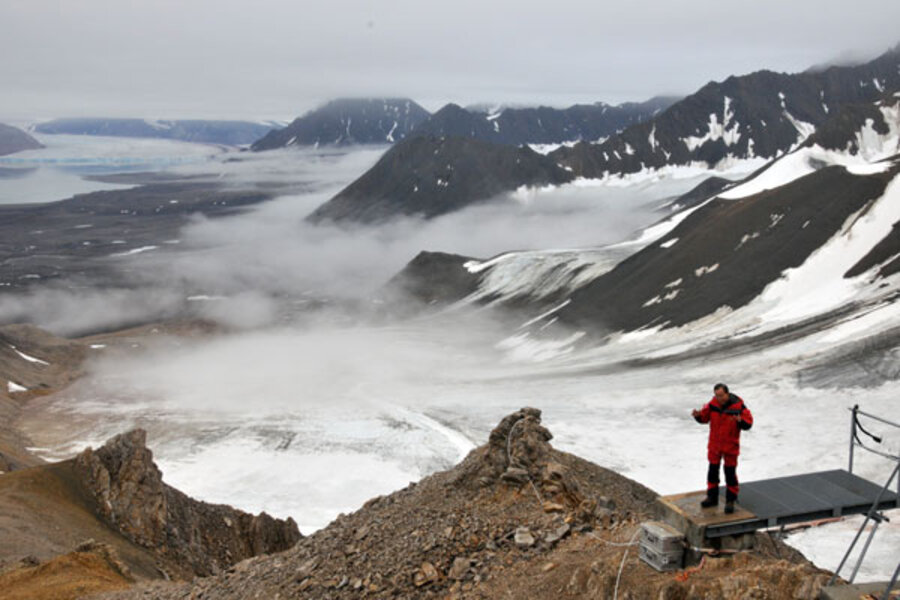Comparing Earth's current warming to the Pliocene
Loading...
About 4.5 million years ago, during the early Pliocene period (3 to 5 million years ago), temperatures on Earth were some 3 to 4 degrees C (5.4 to 7.2 degrees F.) higher in the tropics, and perhaps 10 degrees C (18 degrees F.) warmer near the poles.
To get that much warming, current climate models have to pump up atmospheric carbon dioxide levels to between 500 and 600 parts per million — about twice the preindustrial level of 280 ppm.
We're currently around 387 ppm. And, given the lack of progress so far toward curbing fossil-fuel emissions, we'll be fortunate to stabilize atmospheric concentrations at 450 ppm.
Scientists are therefore quite interested in what the world looked like during the early Pliocene, and why. At least in terms of atmospheric CO2 concentrations, that seems to be where we're headed.
A new paper in Nature Geoscience concludes that we may, in fact, already be there. According to current climate models, with each doubling of CO2, Earth warms around 3 degrees C (5.4 degrees F.). Scientists have deduced, therefore, that atmospheric CO2 concentrations during the Pliocene must have been between 500 and 600 ppm.
But according to this study, the fossil evidence doesn't support that assumption. Carbon dioxide concentrations in the early Pliocene, as inferred from several sources, were more likely between 365 and 415 ppm. We're already well within that range.
The implications are (at least) two-fold: 1. It takes a lot less CO2 to warm Earth than previously thought. 2. Earth's climate may be more sensitive to increases in CO2 than current climate models assume.
"[T]he Earth-system climate sensitivity has been significantly higher over the past five million years than estimated from fast feedbacks alone," write the authors.
Antarctic ice cores allow us to directly measure earth's air going back 800,000 years. Beyond that, we have to infer atmospheric CO2 concentrations from other sources.
The authors of this paper looked at isotopic signatures in organic compounds called alkenones. Alkenones are produced by phytoplankton, photosynthetic ocean-dwelling organisms with unpronounceable names like coccolithophorids and prymnesiophytes.
These organisms, like all photosynthesizers, take the carbon atom from CO2 in the air, freeing the two oxygen atoms. Scientists can infer from the ratio of carbon carbon 13 to carbon 12 isotopes in their tissues — and the alkenone that remains behind in ocean sediments — what the concentration of CO2 was in the ocean's surface layers.
There are some caveats with this approach, as an accompanying article points out.
But temperature reconstructions from at least one other source — the ratio of boron to calcium in fossilized shells — support the basic finding: Atmospheric carbon dioxide concentrations during the early Pliocene were significantly lower than previously assumed. They were just 90 to 125 ppm more than preindustrial levels of 280 ppm — in other words, about where we are now.
What do these findings mean? They indicate that the Pliocene might be the best analog for the world in the not-too-distant future. They also imply that our climate models, which account for short-term feedbacks like water vapor and sea-ice formation, but don't include feedback cycles that take place on a longer time scales — receding ice sheets and vegetation changes, for example — significantly underestimate CO2's impact on Earth's climate.
As models improve and scientists have more proxy reconstructions of paleoclimate at their fingertips, this seems to be a recurring theme.
Last year, we wrote about scientists looking at the Paleocene-Eocene Thermal Maximum (PETM) — a spike in temperatures that occurred about 55 million years ago. The PETM was warmer than the Pliocene, and, on average, about 7 degrees C warmer than today. Palm trees grew in Antarctica and alligators inhabited swamps above the Arctic Circle.
In models, these researchers also couldn't reproduce the warmer PETM conditions by increasing just CO2. When they put in the CO2 they know existed, they got only about half the warming they know occurred.
As a result, they concluded that Earth's climate was much more sensitive to changes in atmospheric CO2 concentration than was commonly assumed. They faulted as-yet-unidentified positive feedbacks other than carbon dioxide for this added warmth. One of their more intriguing conjectures was the probability of a greater number of swamps in a warmer world. Swamps produce lots of methane, and methane is more than 20 times more effective at trapping heat than CO2.
Editor’s note: The Monitor's Environment section has a new URL. And there's a new URL for its Bright Green blog. We hope you'll bookmark these and visit often.





